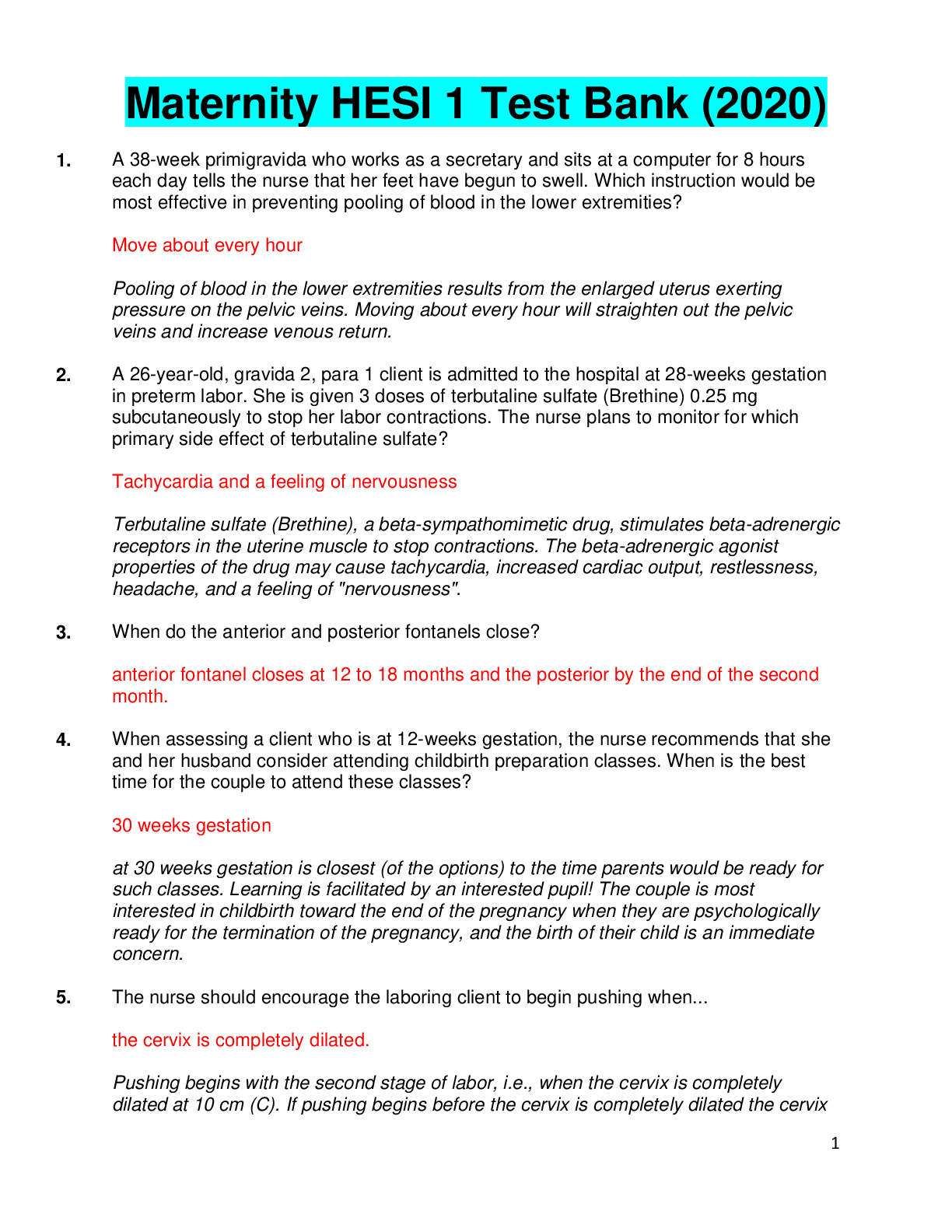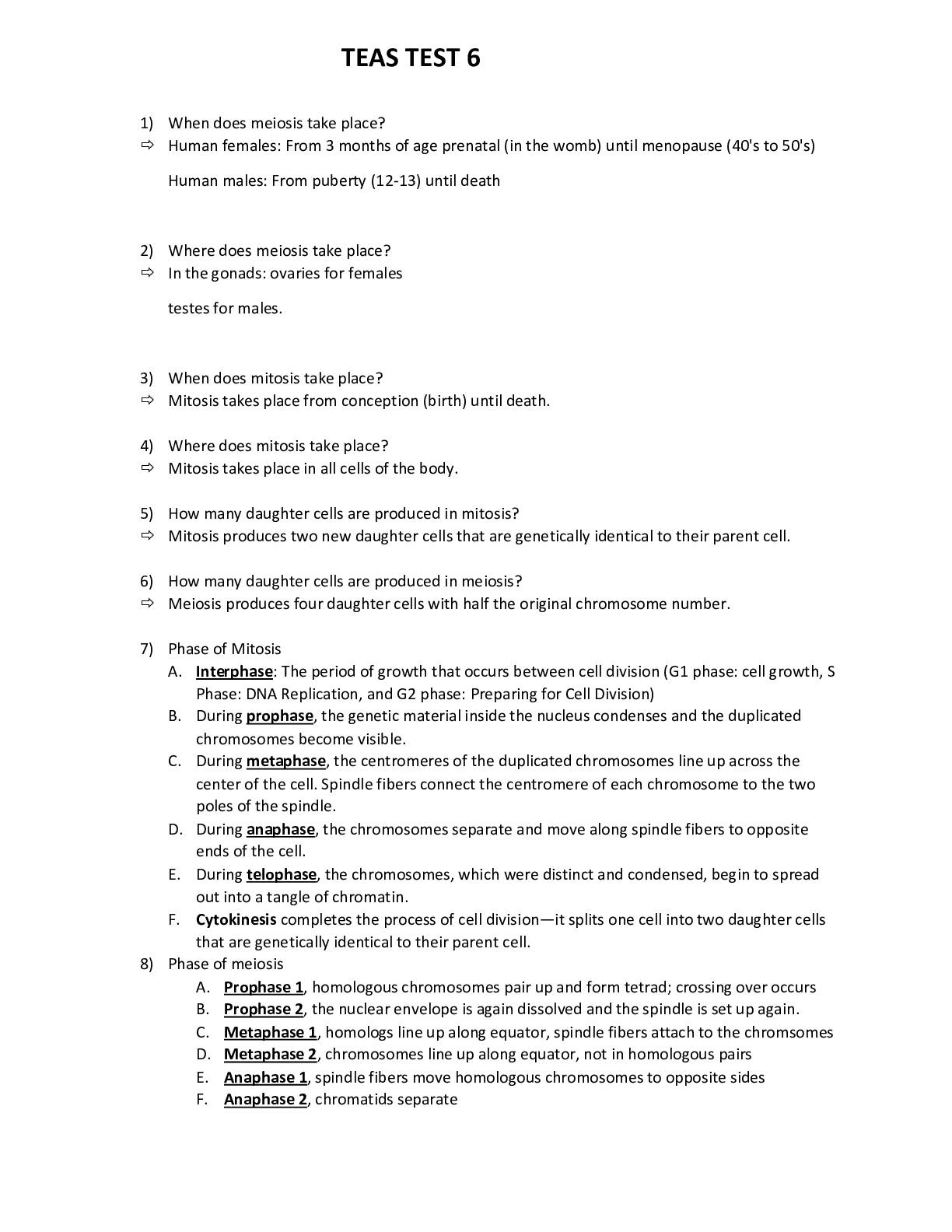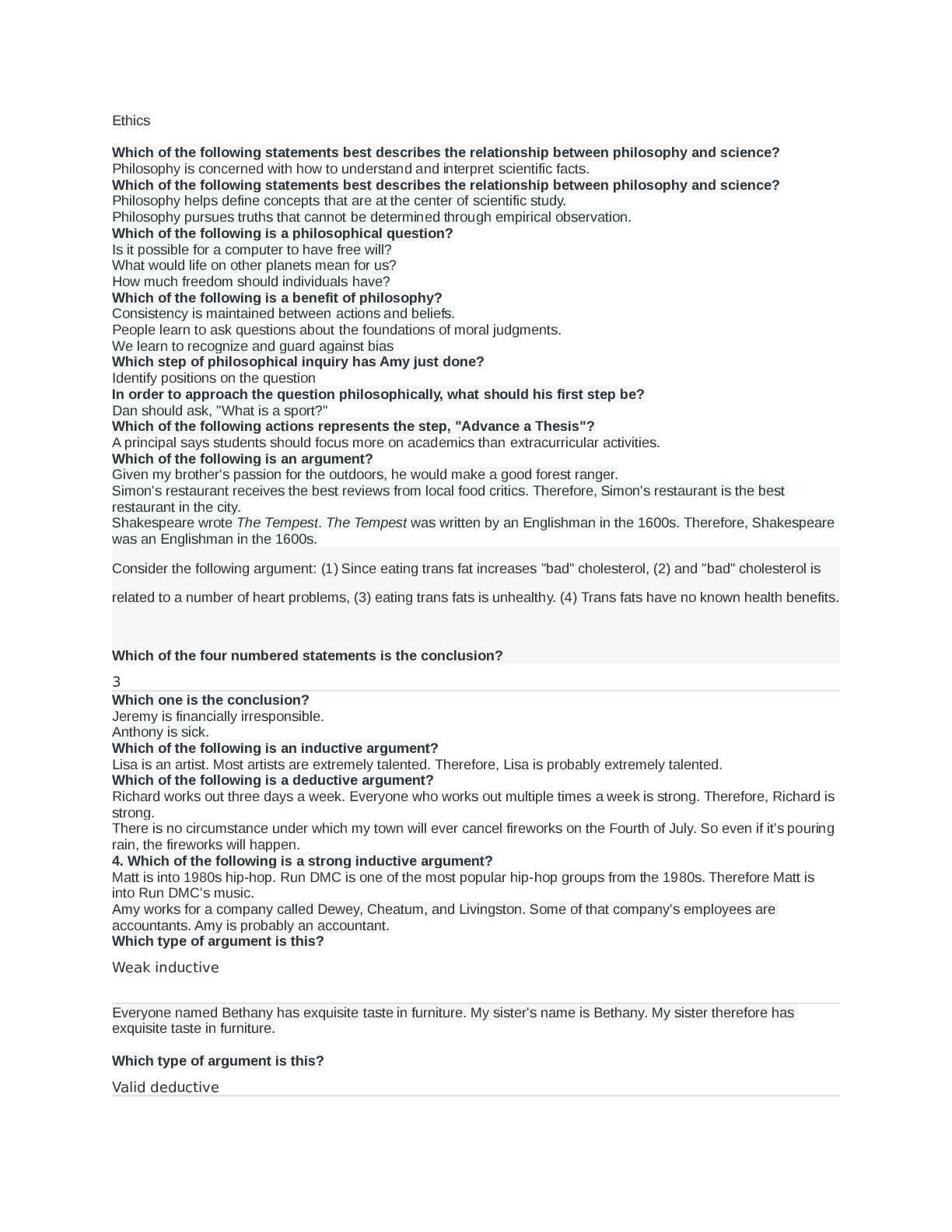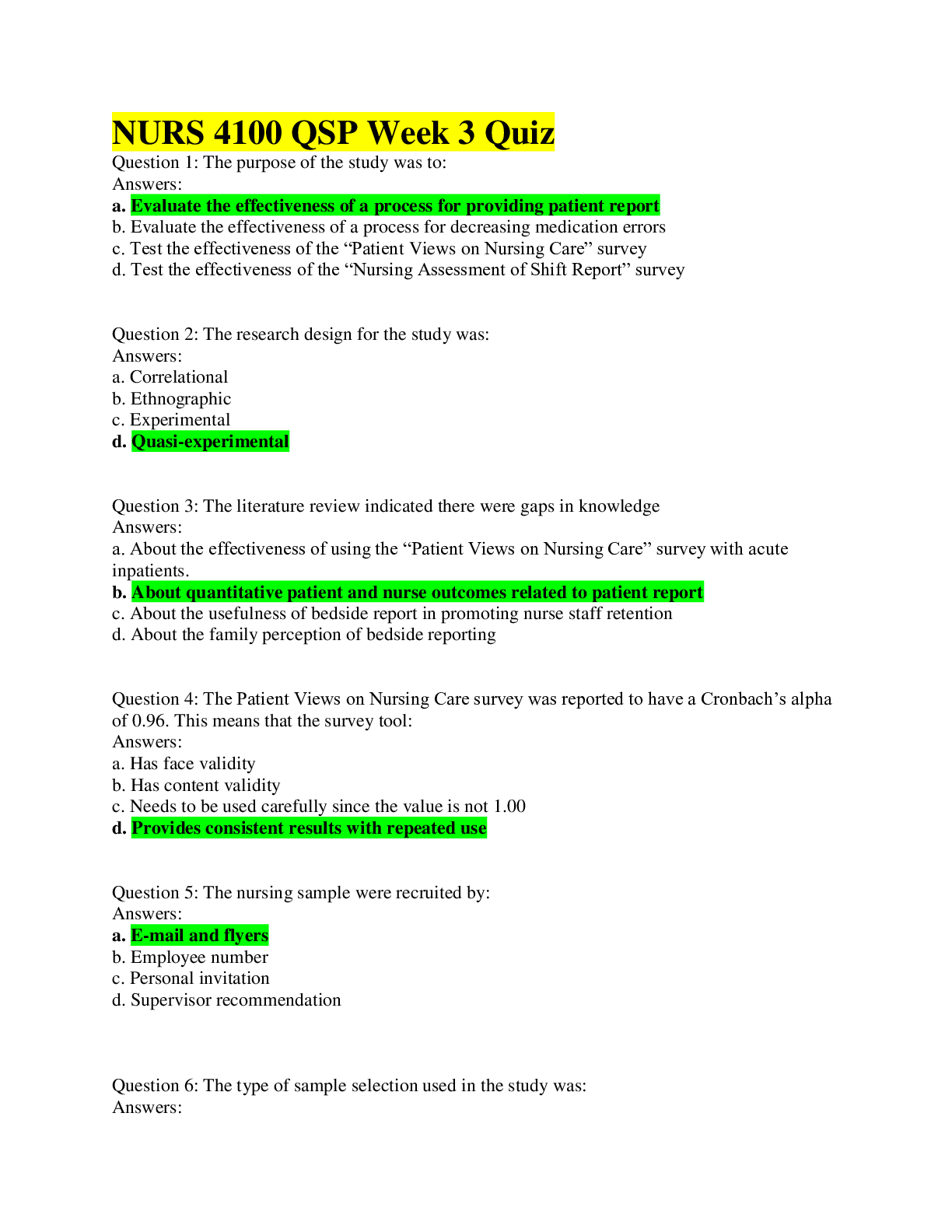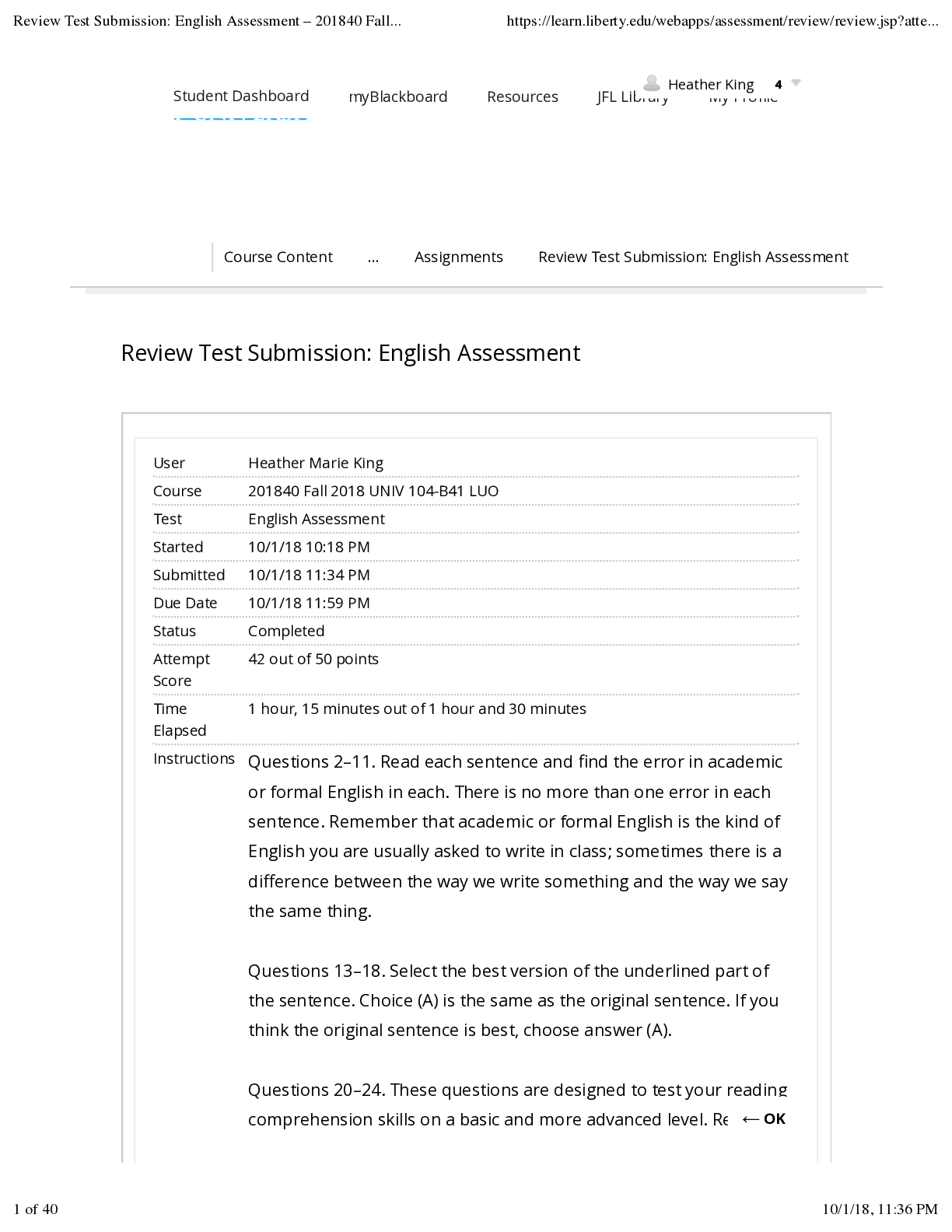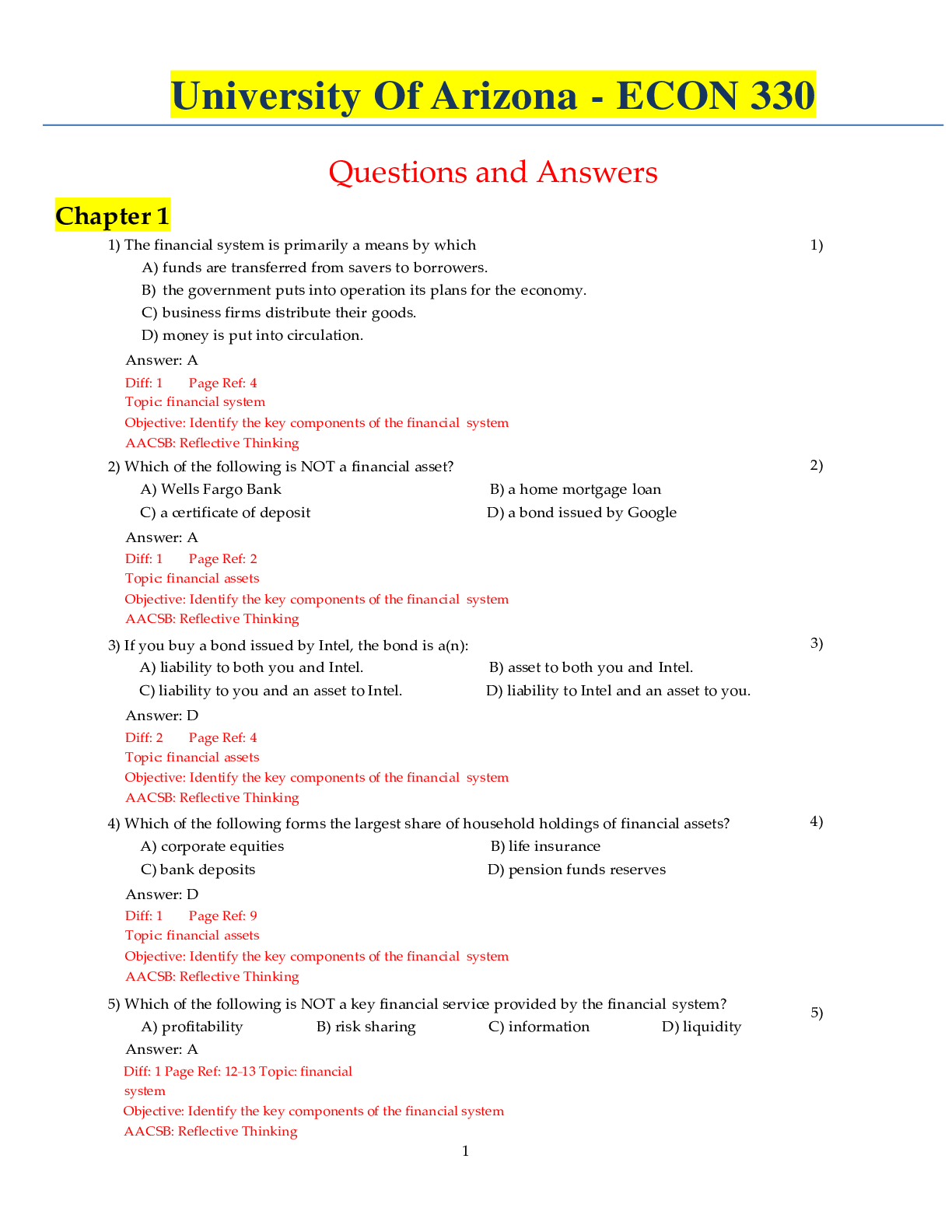Business > QUESTIONS & ANSWERS > GSCM 206 all Weekly Quizzes 1-7 Questions and Answers (corrected & Verified) 2019/2020 (All)
GSCM 206 all Weekly Quizzes 1-7 Questions and Answers (corrected & Verified) 2019/2020
Document Content and Description Below
GSCM 206 all Weekly Quizzes 1-7 Questions and Answers (corrected & Verified) Week 1 Grade Details - All Questions Question 1. Question : (TCO 1) What are the five elements in the management proce... ss? Plan, direct, organize, pricing, and supervise Accounting/finance, marketing, operations, and management Organize, plan, implement, staff, and lead All of the above None of the above They are plan, organize, staff, lead, and control. See Chapter 1, page 7. Question 2. Question : (TCO 2) Which of the following are the competing forces in Porter’s five forces model? Rivals Potential entrants Customers and suppliers Substitute products All of the above Chapter 2, page 38 3 of 3 Question 3. Question : (TCO 1) An operations task performed at Hard Rock Café is borrowing funds to build a new restaurant. advertising changes in the restaurant menu. calculating restaurant profit and loss. preparing employee schedules. All of the above Chapter 1, pages 24. 3 of 3 Question 4. Question : (TCO 4) Riverside Metal Works produces cast bronze valves on a five-person assembly line. On a recent day, 180 valves were produced during an 8-hour shift. Calculate the labor productivity of the line. 2 valves per labor hour 3.5 valves per labor hour 4.5 valves per labor hour 5 valves per labor hour The answer is 180 valves/ (8 hours x 5 people) = 180 valves /40 labor hours = 4.5 valves/labor. See Formula 1.1, Chapter 1, pages 14 and 15, and Solved Problems. 3 of 3 Question 5. Question : (TCO 4) Gibson Valves produces cast bronze valves on an assembly line, currently producing 2,000 valves during each 8-hour shift. If the production is increased to 2,400 valves for each 8-hour shift, the productivity will increase by _____. 10% 20% 25% 40% 50% The answer is 2,000 valves/8 hours = 250 values/hour; 2,400 valves/8 hours= 300 values/hour; 300/250 = 1.2; 120% or 20% increase. See Formula 1.1, Chapter 1, pages 14 and 15, and Solved Problems. 3 of 3 Question 6. Question : (TCO 4) Susan has a part-time "cottage industry" producing seasonal plywood yard ornaments for resale at local craft fairs and bazaars. She currently works a total of 5 hours per day to produce 10 ornaments. She thinks that by redesigning the ornaments and switching from the use of wood glue to a hot glue gun that she can increase her total production to 25 ornaments per day. What is her new productivity? Two ornaments per hour Three ornaments per hour Four ornaments per hour Five ornaments per hour The answer is 25 ornaments/5 hours = 5 ornaments/hour. See Formula 1.1, Chapter 1, pages 14 and 15, Solved Problems. 3 of 3 Question 7. Question : (TCO 2) Which is not true regarding differences between goods and services? Tangible goods are generally produced and consumed simultaneously; services are not. Most goods are common to many customers; services are often unique to the final customer. Services tend to have a more inconsistent product definition than goods. Services tend to have higher customer interaction than goods. All of the above Table 1.3, Chapter 1, pages 11 Question 8. Question : (TCO 2) Which of the following is an example of competing on quick response? A firm produces its product with less raw material waste than its competitors. A firm offers more reliable products than its competitors. A firm's products are introduced into the market faster than its competitors. A firm's research and development department generates many ideas for new products. Chapter 2, page 37 3 of 3 Question 9. Question : (TCO 2) The impact of a firm's strategies to achieve their mission is which of the following? They exploit opportunities and strengths. They operate on medium-range tactics. They are not long range. They neutralize threats and avoid weaknesses. They both exploit opportunities and strengths, and they neutralize threats and avoid weaknesses. They exploit opportunities and strengths and neutralize threats and avoid weaknesses (SWOT). See Chapter 2, pages 39–40. 3 of 3 Question 10. Question : (TCO 4) According to the authors, what are the three key strategic concepts that allow firms to achieve competitive advantage? Productivity, efficiency, and quality leadership Differentiation, cost leadership, and efficient response Differentiation, cost leadership, and quick response Distinctive competency, cost leadership, and experience Chapter 2, page 34 3 of 3 Week 2 Grade Details - All Questions Question 1. Question : (TCO 5) What is the forecast for May, based on a weighted moving average applied to the following past-demand data and using the weights 4, 3, and 2 (largest weight is for most recent data)? Nov. Dec. Jan. Feb. March April 37 36 40 42 47 41 42.5 33.6 40.3 44.1 43.22 The answer is W/M/A = [(4 x 41) + (3 x 47) + (2 x 42)]/9 = [164 + 141 + 84]/9 = 389/9 = 43.22. See Formula 4-2 and the example that follows, Chapter 4, page 111. 3 of 3 Question 2. Question : (TCO 5) Jim's department at a local department store has tracked the sales of a product over the last 10 weeks using exponential smoothing with an alpha of 0.3. In January, he forecasted $150,000 in sales and achieved $155,000 is sales. Using this same forecasting model, estimate Jim’s February sales. $152,000 $155,000 $151,500 $105,000 The answer is E/M = $150,000 + [0.3($155,000 - $150,000)] = $150,000 + [0.3($5,000)] = $150,000 + ($1500) = $151,500. See Formula 4-3 and the example that follows, Chapter 4, page 113. 3 of 3 Question 3. Question : (TCO 5) Using a 3-year moving average, forecast the amount for Year 10. Year Demand 1 74 2 90 3 59 4 91 5 140 6 98 7 120 8 123 9 99 Year 10 = 122.87 Year 10 = 99.98 Year 10 = 110.67 Year 10 = 114 The answer is M/A = (120 + 123 + 99)/3 = 114. See Formula 4-1 and the example that follows, Chapter 4, page 110. 3 of 3 Question 4. Question : (TCO 6) Which of the following helps operations managers focus on the trivial few and the critical many? Value analysis Value engineering Financial analysis Product-by-value analysis None of the above Chapter 5, page 156 3 of 3 Question 5. Question : (TCO 7) Which of the following moments of truth exemplifies the customer's standard expectations? Your advisor made you wait, even though you had an appointment. You had to visit once to reach your academic advisor. Your advisor was competent, helpful, and understanding. Your advisor failed to keep his or her appointment with you. Figure 5.13, Chapter 5, page 175 Question 6. Question : (TCO 5) Forecasts are usually classified by time horizon into three categories. What are they? Short range, medium short, and long range Finance and accounting, marketing, and operations Strategic, tactical, and operational Exponential smoothing, regression, and time series Long range, medium range, and short range Chapter 4, page 104 Question 7. Question : (TCO 7) Which product life cycle phase has the following characteristics: established competitors, stable product sales, and improved cost control? Maturity Introduction Decline Growth None of the above Chapter 5, page 159 3 of 3 Question 8. Question : (TCO 7) The specific components inputted into the fourth house in the house of quality are satisfied by _____. the quality plan customer requirements design characteristics the production process Chapter 5, page 163 3 of 3 Question 9. Question : (TCO 5) In time series, which of the following cannot be predicted? Random variations “blips” Technological trends Seasonal fluctuations Regular fluctuations Large decreases in demand Chapter 4, page 108 3 of 3 Question 10. Question : (TCO 6) An assembly drawing _____. shows an exploded view of the product shows graphically how the product is assembled lists the operations, including assembly and inspection, necessary to produce the component with the material specified in the bill of material provides detailed instructions on how to perform a given task Figure 5.11, Chapter 5, page 172 3 of 3 Week 3 1. Question : (TCO 3) Customer dissatisfaction, rework, and warranty costs are cost associated with the _____. quality loss function (QLF) Pareto chart cost of quality process chart Chapter 6, page 210 3 of 3 Question 2. Question : (TCO 3) According to the ASQ-based definition of quality, _____. quality is the totality of features and characteristics of a product or service that bears on its ability to satisfy stated or implied needs quality depends on how well the product fits patterns of consumer preferences, and even though quality cannot be defined, you know what it is quality is the degree to which a specific element conforms to standards quality lies in the eyes of the beholder Chapter 6, page 209 3 of 3 Question 3. Question : (TCO 3) Which of the following is not one of the major categories of costs associated with quality? Fluctuating costs Appraisal costs Internal failures External costs None of the above; all of these are major categories associated with the cost of quality. Chapter 6, page 210 3 of 3 Question 4. Question : (TCO 8) An example of product-focused processes produce _____. projects and job shops commercial baked good, steel, and beer automobiles and home appliances computers Chapter 7, page 274 3 of 3 Question 5. Question : (TCO 3) Which of the following does total quality management emphasize? Employee empowerment The responsibility of the quality control staff to identify and solve all quality-related problems A system where strong managers are the only decision makers A process where mostly statisticians get involved ISO 14000 certification Chapter 6, page 214 3 of 3 Question 6. Question : (TCO 3) Pareto charts are _____. a way of organizing errors, problems, or defects a graphical way to identify processes used to indicate which p may yield the least payoff All of the above Chapter 6, page 219 Question 7. Question : (TCO 8) A drawing of the movement of material or people is a _____. flow process process chart service blueprint flowchart Chapter 7, page 259 3 of 3 Question 8. Question : (TCO 8) What is the automated system that uses an automated work cell controlled by electronic signals from a common centralized computer facility? SPC CAD/CAM CIM ASRS FMS Chapter 7, page 287 3 of 3 Question 9. Question : (TCO 8) Which of the following is the most correct? Mass customization is about providing low-cost goods and services. Mass customization is about fulfilling unique customer desires. Mass customization is about providing low-cost goods and services and fulfilling unique customer desires. Mass customization is about making exactly what the producer wants, when they want it, and at a low cost too. None of the above Chapter 7, pages 274–275 3 of 3 Question 10. Question : (TCO 8) An organization's process strategy _____. will have a long-term impact on efficiency and flexibility of production is the same as its transformation strategy must meet various constraints, including cost is concerned with how resources are transformed into goods and services All of the above Chapter 7, page 272 3 of 3 Week 4 Grading Summary These are the automatically computed results of your exam. Grades for essay questions, and comments from your instructor, are in the "Details" section below. Date Taken: 9/23/2016 Time Spent: 20 min , 33 secs 30 / 30 (100%) Question Type: # Of Questions: # Correct: Multiple Choice 10 10 Grade Details - All Questions Question 1. Question : (TCO 8) The Clothes Factory wants to increase capacity by adding a new sewing machine. The fixed costs for machine A are $9,000, and its variable cost is $4 per unit. The revenue is $7 per unit. The break-even point for the sewing machine is 1,200 units. 1,600 units. 3,000 units. 1,500 units. See equation S7-4, Supplement 7, page 308. 3 of 3 Question 2. Question : (TCO 9) A full-service restaurant is considering opening a new facility in a specific city. The table below shows its ratings of four factors at each of two potential sites. Factor Weight Wind City State Line Affluence of local population .40 25 25 Traffic flow .20 50 20 Parking availability .10 30 40 Growth potential .30 10 30 The score for Wind City is _____ and the score for State Line is _____. Wind City = 7.00; State Line = 7.25 Wind City = 14; State Line = 14.50 Wind City = 28; State Line = 29 Wind City = 26; State Line = 27 See Example 1, Chapter 8, pages 333–334. Wind City = [(0.40 x 25) = (0.20 x 50) + (0.10 x 30) + (0.30 x 10)] = [10 + 10 + 3 + 3] = 26: State Line = [(0.40 x 25) = (0.20 x 20) + (0.10 x 40) + (0.30 x 30)] = [10 + 4 + 4 + 9] = 27. 3 of 3 Question 3. Question : (TCO 8) ABC Cleaners' washing machines have a design capacity of 2,900 pounds a day. Because of scheduled maintenance of their equipment, management feels that only 2,500 pounds of clothes can be washed in a day. Yesterday, three employees were sick and only 2,100 pounds of clothes were washed. What was the utilization of the washing machine yesterday? 25% 75% 72.4% 95% See equation S7-1, Supplement 7, page 299. 3 of 3 Question 4. Question : (TCO 8) A bakery has a design capacity to bake 200 loaves of bread a day. However, because of scheduled maintenance of their equipment, management feels that they can bake 100 loaves a day. Yesterday the gas was turned off while the city was repairing a leak and only 22 loaves where baked. What was the efficiency of the ovens yesterday? 5% 7% 10% 22% See equation S7-2, Supplement 7, page 299. Efficiency = actual output/effective capacity = (22/100) x 100 = 0.22 x 100 = 22.0%. 3 of 3 Question 5. Question : (TCO 8) Design capacity is the maximum output of a system in a given period. actual production over a specified time period in ideal conditions. average output that can be achieved under ideal conditions. maximum usable capacity of a particular facility. the capacity a firm expects to achieve given the current operating constraints. Supplement 7, page 299 3 of 3 Question 6. Question : (TCO 8) Fixed costs are costs that vary with volume of units produced. the difference between the selling price and variable costs. not a part of the break-even analysis. costs that do not continue even if no units are produced. None of the above Supplement 7, page 307 3 of 3 Question 7. Question : (TCO 9) When making a location decision at the region or community level, which of these would be considered? Government rules, attitudes, stability, and incentives Location of markets Air, rail, highway, and waterway systems Zoning restrictions None of the above Figure 8.1, Chapter 8, page 330 3 of 3 Question 8. Question : (TCO 9) The focus in service location strategy is on minimizing cost. maximizing customer input. locating far away from competition. None of the above Chapter 8, page 338 3 of 3 Question 9. Question : (TCO 9) Community attitudes, zoning restrictions, and quality of labor force are likely to be considered in which of the following location decision methods? Transportation method Locational break-even analysis Factor rating method Simulation Factor processes Figure 8.1, Chapter 8, page 333 3 of 3 Question 10. Question : (TCO 8) An operation that is the limiting factor or constraint is called a _____. drum, buffer, rope bottleneck throughput capacity Supplement 7, page 304 3 of 3 Week 5 Grading Summary These are the automatically computed results of your exam. Grades for essay questions, and comments from your instructor, are in the "Details" section below. Date Taken: 9/30/2016 Time Spent: 23 min , 10 secs 30 / 30 (100%) Question Type: # Of Questions: # Correct: Multiple Choice 10 10 Grade Details - All Questions Question 1. Question : (TCO 3) Which of the following is not a concern of the supply chain? Number of internal managers Credit and cash transfers Vendor reliability Distributors and banks Having fewer suppliers Chapter 11, page 432 3 of 3 Question 2. Question : (TCO 2) Which of the following best describes vertical integration? To purchase supplier or a distributor To develop the ability to produce products which complement the original product To produce goods or services previously purchased Both to purchase supplier or a distributor and to produce goods or services previously purchased Chapter 11, page 436 3 of 3 Question 3. Question : (TCO 3) Japanese manufacturers often take a middle ground between purchasing from a few suppliers and vertical integration. This approach is kanban. keiretsu. samurai. poka-yoke. kaizen. Chapter 11, page 436 3 of 3 Question 4. Question : (TCO 2) Building a chain of suppliers that focuses on maximizing value to the ultimate customer is the primary objective of supply chain strategy. to select suppliers primarily on response or differentiation. the goal of production lead time. to increase the number of suppliers. Chapter 11, pages 432 3 of 3 Question 5. Question : (TCO 2) Long-term partnering with a few suppliers is a supply-chain strategy that creates value by allowing suppliers to become part of a company coalition. enjoy the economies of scale. become vertically integrated. negotiate with many suppliers. Chapter 11, page 435 3 of 3 Question 6. Question : (TCO 3) In the make-or-buy decision, which of the following is a reason for making an item? Management focus on its primary business To ensure an adequate supply in terms of quantity Inadequate capacity Reduce inventory costs Chapter 11, pages 434–435 3 of 3 Question 7. Question : (TCO 3) What theory states that you should allow another firm to perform work activities for your company if that company can do it more productively than you can? Theory of competitive advantage Theory of core competencies Theory of comparative advantage Theory of outsourcing Theory of offshoring Chapter 2, page 44 3 of 3 Question 8. Question : (TCO 3) Which of the following is NOT an advantage of outsourcing? Cost savings Gaining outside expertise Improving operations and service Outsourcing core competencies Gaining outside technology Chapter 2, page 45 3 of 3 Question 9. Question : (TCO 2) Which of the following is not a concern of the supply chain? Warehousing and inventory levels Credit and cash transfers Suppliers Distributors and banks Maintenance scheduling Chapter 11, pages 432–433 3 of 3 Question 10. Question : (TCO 2) Which type of negotiating strategy requires the supplier to open its books to the purchasers? Cost-based price model Market-based price model Competitive bidding Price-based model None of the above Chapter 11, page 443 3 of 3 Week 6 Grading Summary These are the automatically computed results of your exam. Grades for essay questions, and comments from your instructor, are in the "Details" section below. Date Taken: 10/7/2016 Time Spent: 45 min , 54 secs 27 / 30 (90%) Question Type: # Of Questions: # Correct: Multiple Choice 10 9 Grade Details - All Questions Question 1. Question : (TCO 11) ABC analysis is based upon the principle that all items in inventory must be monitored very closely. there are usually a few critical items and many items that are less critical. an item is critical if its usage is high. more time should be spent on managing "C" items because there are more of them. there should be more “B” items than either “A” or “C” items. Chapter 12, page 477-479. 3 of 3 Question 2. Question : (TCO 11) ABC analysis divides on-hand inventory into three classes, generally based upon item quality. unit price. the number of units on hand. annual demand. annual dollar volume. Chapter 12, pages 477–479 3 of 3 Question 3. Question : (TCO 11) Which of the following is an element of inventory holding costs? Housing costs Material handling costs Investment costs Pilferage, scrap, and obsolescence All of the above Chapter 12, page 482 3 of 3 Question 4. Question : (TCO 11) A certain type of computer costs $1,000, and the annual holding cost is 25%. Annual demand is 10,000 units, and the order cost is $150 per order. What is the approximate economic order quantity? 16 70 110 183 600 Example 3, Chapter 12, page 485 Question 5. Question : (TCO 11) The purpose of safety stock is to replace failed units with good ones. eliminate the possibility of a stockout. eliminate the likelihood of a stockout because of erroneous inventory tally. control the likelihood of a stockout because of the variability of demand during lead time. protect the firm from a sudden decrease in demand. Chapter 12, page 488 3 of 3 Question 6. Question : (TCO 10) Effective use of MRP and other dependent demand models does not require which of the following? Master production schedule Bill of materials Inventory availability Lead times Cost of individual components Chapter 14, page 554 3 of 3 Question 7. Question : (TCO 10) The _____ is (are) the MRP input detailing that end items are to be produced, when they are needed, and in what quantities. master production schedule load report inventory records assembly time chart bill of material Chapter 14, page 555 3 of 3 Question 8. Question : (TCO 10) A document calls for the production of 50 small garden tractors in week 1; 50 small garden tractors and 100 riding mowers in week 2; 100 riding mowers and 200 garden utility carts in week 3; and 100 riding mowers in week 4. This document is most likely a(n) net requirements document. resource requirements profile. aggregate plan. master production schedule. Wagner-Whitin finite capacity document. Chapter 14, pages 555–556 3 of 3 Question 9. Question : (TCO 10) Why is low-level coding use in a bill of material (BOM)? They are planning BOM. They are phantom BOM. Identical items does not exist in the BOM. Identical items exist in the BOM. Chapter 14, page 558 3 of 3 Question 10. Question : (TCO 10) The bill of material contains information necessary to place an order to replenish the item. calculate quantities on hand and on order. convert net requirements into higher level gross requirements. convert gross requirements into net requirements. convert (explode) net requirements at one level into gross requirements at the next level. Chapter 14, page 556 3 of 3 Week 7 Grading Summary These are the automatically computed results of your exam. Grades for essay questions, and comments from your instructor, are in the "Details" section below. Date Taken: 10/13/2016 Time Spent: 24 min , 36 secs 27 / 30 (90%) Question Type: # Of Questions: # Correct: Multiple Choice 10 9 Grade Details - All Questions Question 1. Question : (TCO 3) Which one of the following is not a JIT quality tactic? Use of statistical process control Empowered employees Fail safe methods Provide immediate feedback Use large lot sizes Chapter 16, page 632 3 of 3 Question 2. Question : (TCO 3) Manufacturing cycle time is best defined as the time between the arrival of raw materials and the shipping of finished products. time it takes a unit to move from one workstation to the next. time between the start of one unit and the start of the next unit. time from raw materials shipment to finished product exit. Chapter 16, page 628 3 of 3 Question 3. Question : (TCO 3) Which of the following is a goal of JIT partnerships? Reduce inventory and variability Increase variability Increase in-transit inventory Elimination of engineering changes Chapter 16, page 629 3 of 3 Question 4. Question : (TCO 3) Just-in-time systems make demands on layouts, except distance reduction. decreased flexibility. reduced space and inventory. All of the above Chapter 16, page 631 3 of 3 Question 5. Question : (TCO 3) Which one of the following is not a JIT inventory tactic? Reduce setup time Use a push system to move inventory Reduce lot size Reduce work-in-process inventory Table 16.2, Chapter 16, page 632 3 of 3 Question 6. Question : (TCO 3) Which of the following is specifically characterized by a focus on continuous improvement, respect for people, and standard work practices? Just-in-time (JIT) Toyota Production System (TPS) Lean Operations Material requirements planning (MRP) Kanban Chapter 16, page 626 Question 7. Question : (TCO 3) Which of the following is not a reason for variability? Employees, machines, and suppliers produce units late. Customer demand is unknown. Employees, machines, and suppliers produce units that conform to standards. Engineering drawings are inaccurate. Drawings or specifications are incomplete. Chapter 16, page 627 3 of 3 Question 8. Question : (TCO 3) What is the time required to move orders through the production process from receipt to delivery? Throughput Manufacturing cycle time Pull time Push time Queuing time Chapter 16, page 628 3 of 3 Question 9. Question : (TCO 3) Throughput measures the time that it takes to process one unit at a station. between the arrival of raw materials and the shipping of finished products. to produce one whole product through an empty system (i.e., with no waiting). required to move orders through the production process, from receipt to delivery. None of the above Chapter 16, page 628 3 of 3 Question 10. Question : (TCO 3) Which of the following is not a goal of JIT partnerships? Removal of unnecessary activities Removal of in-plant inventory Removal of in-transit inventory Removal of engineering changes All of the above Chapter 16, page 629 3 of 3 [Show More]
Last updated: 1 year ago
Preview 1 out of 32 pages
Instant download

Buy this document to get the full access instantly
Instant Download Access after purchase
Add to cartInstant download
Reviews( 0 )
Document information
Connected school, study & course
About the document
Uploaded On
Jun 28, 2020
Number of pages
32
Written in
Additional information
This document has been written for:
Uploaded
Jun 28, 2020
Downloads
0
Views
33

.png)



